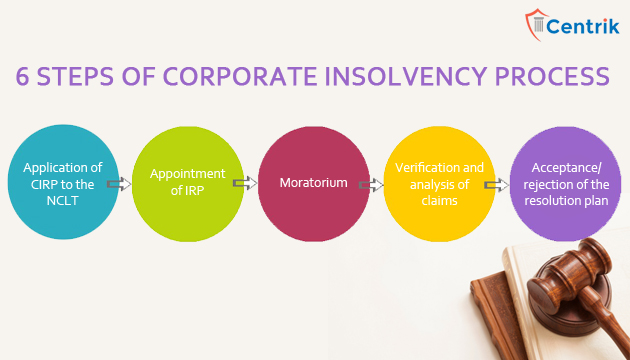
Status as on- 24/11/2022
Introduction
What is CIRP?
A company is said to be insolvent when it is unable to pay back its debts and settle the balance with its creditors.
The corporate Insolvency Resolution Process acts as a recovery mechanism for creditors and they have the power to initiate the corporate insolvency resolution process if a corporation becomes insolvent.
CIRP may be initiated by a financial creditor under section 7, an operational creditor under section 9, and a corporate applicant of a corporate debtor under section 10 of the Code.
It is the process of resolving the corporate insolvency of a corporate debtor in accordance with the provisions of the Code.
CIRP is a process to determine the capability of repayment of the defaulted corporate. For this purpose, IRPs are appointed. They evaluate the assets and liabilities to determine the capability of repayment.
Creditors and types:
Creditor as defined in Section 3(10) of the Insolvency and Bankruptcy Code means any person to whom a debt is owed and includes a financial creditor, an operational creditor, a secured creditor, an unsecured creditor, and a decree holder.
The Insolvency and Bankruptcy Code aims to give the debtor the opportunity to provide relief to the creditors, which includes:
- Financial Creditors: Financial creditors refers to the person against whom any financial debt relates such as loans or debt security. Financial debt as defined in IBC is a debt along with interest, if any, which is disbursed against the consideration for the time of the value of money.
Ex: Money borrowed from banks and other financial institutions.
- Operational Creditors: Operational creditors are those whose liability on those comes from a transaction of operation. An operational debt is owed to an operational creditor and such debt is legally assigned or transferred.
Operational Debt means claims arising in relation the to supply of goods and services. It also includes claims in relation to employment or dues payable to Central Government, State Government, or any local authority.
- Secured Creditors: These are the people in favor of whom a security interest is created. Security interest means any right, title, or any interest in favor of the creditor by a transaction that secures the creditors’ payment or performance of an obligation and includes mortgage, charge, hypothecation, assignment, and encumbrance or any other agreement or arrangement securing payment or performance of any obligation of any person.
- Unsecured Creditors: An unsecured Creditor is an individual or an institution that lends money without obtaining any asset as collateral.
Stages:
Process of CIRP followed in 6 steps:
-
Application of CIRP to the NCLT:
As discussed above, the creditors have the right to the initiate CIRP process in order to get their money back. The financial and operational creditors after meeting all the criteria for application to the authenticating authority, i.e., NCLT can reach the tribunal for relief.
NCLT after reviewing the petition decides whether the petition holds a locus standi before the tribunal or not and accordingly proceeds further.
-
Appointment of Interim Insolvency Resolution Professional (IRP):
The Interim Insolvency Resolution Professional is a professional appointed by the tribunal. Ones the IRP is appointed the company loses all control relating to the functions and other activities of the Company.
-
Moratorium:
The moratorium period starts as soon as the authenticating authority admits the petition and thereby prohibits certain activities, such as:
- Nor any legal matter/matters pending against the corporate debtor can commence and nor any new case against the corporate debtor can be taken up.
- No recovery of property per se can happen.
- No assets, legal rights, or any beneficial interest can be transferred.
- No action to foreclose, recover or enforce any security interest created by the corporate debtor in respect of its property including any action under the securitization and reconstruction of financial assets and enforcement of the security interest act, 2002.
-
Verification and analysis of claims:
The IRP is responsible for each and every verification of claims made by the corporate debtor’s creditors and makes an analysis derived from the above-mentioned.
IRP also forms the Committee of Creditors.
-
Appointment of Resolution Professional:
The Committee of Creditors further appoints an independent person to operate as the Resolution Professional who will take charge of the CIRP going forward. The Resolution Professional can be the same or different from the Interim Insolvency Resolution Professional.
-
Acceptance/ rejection of the resolution plan:
The resolution plan for the restructuring of the corporate given by the resolution applicants to the creditors should be accepted within 180 days by the creditors. Later, the Adjudicating Authority, i.e., NCLT sanctions the resolution plan and if no resolution plan is accepted in this period, the NCLT is obliged to order the liquidation of the corporate debtor. Further, on approval, the COC appoints the liquidator.
Conclusion
The code has been successful in setting up the steps to make the CIRP process effective and time efficient. The key drawback previously was the non-efficient structure which has been put aside and ,at present the insolvency procedure has been made easy and balanced.
Disclaimer: The above article is based on the personal interpretation of the related orders and laws. The readers are expected to take expert opinions before relying upon the article. For more information, please contact us at rera@centrik.in




 join For Updates
join For Updates